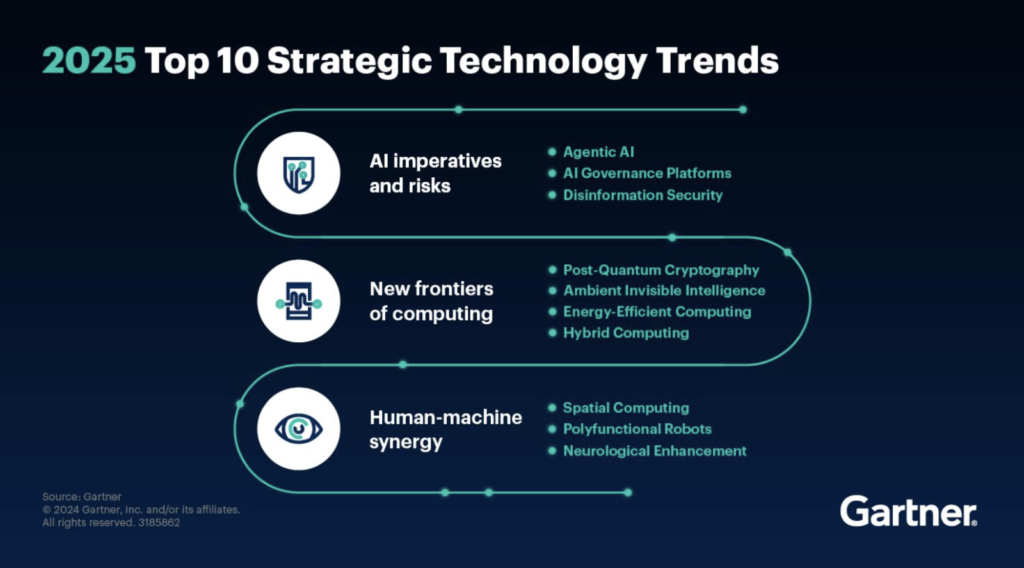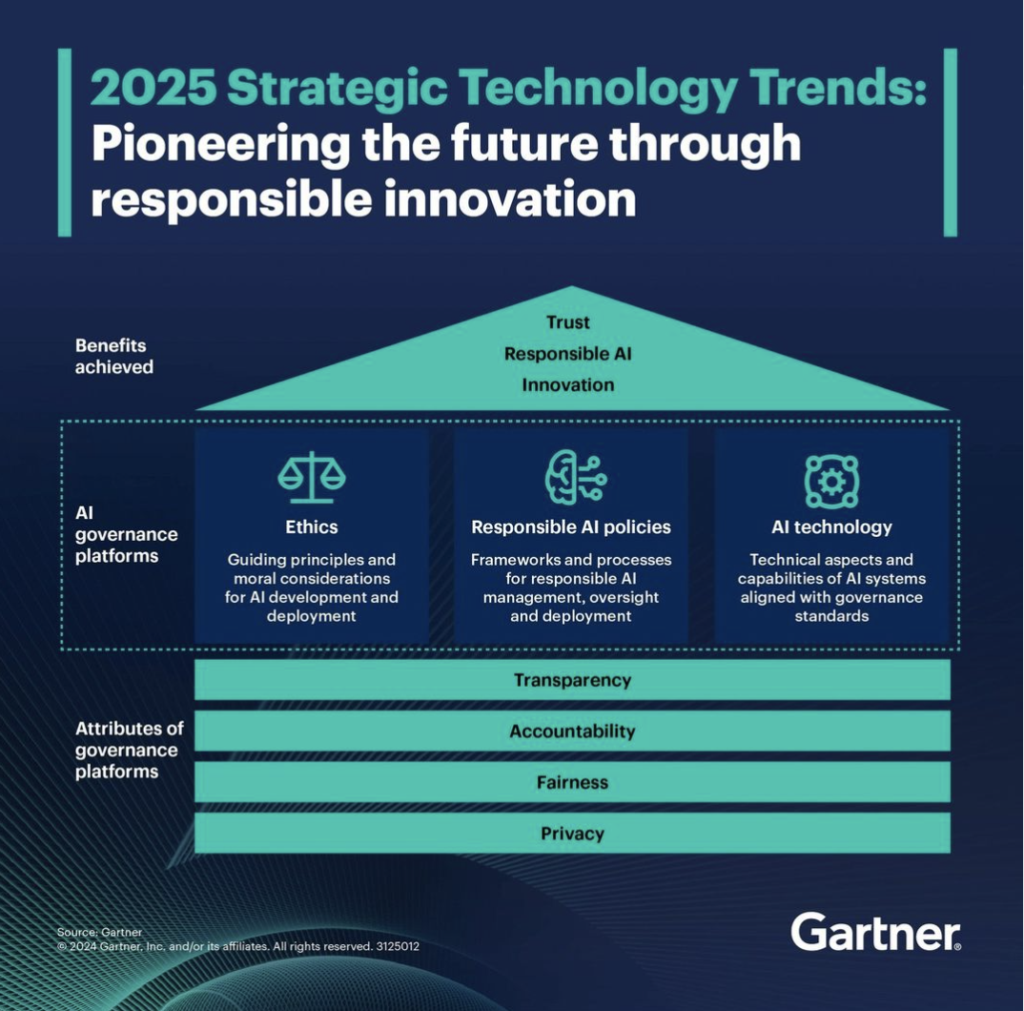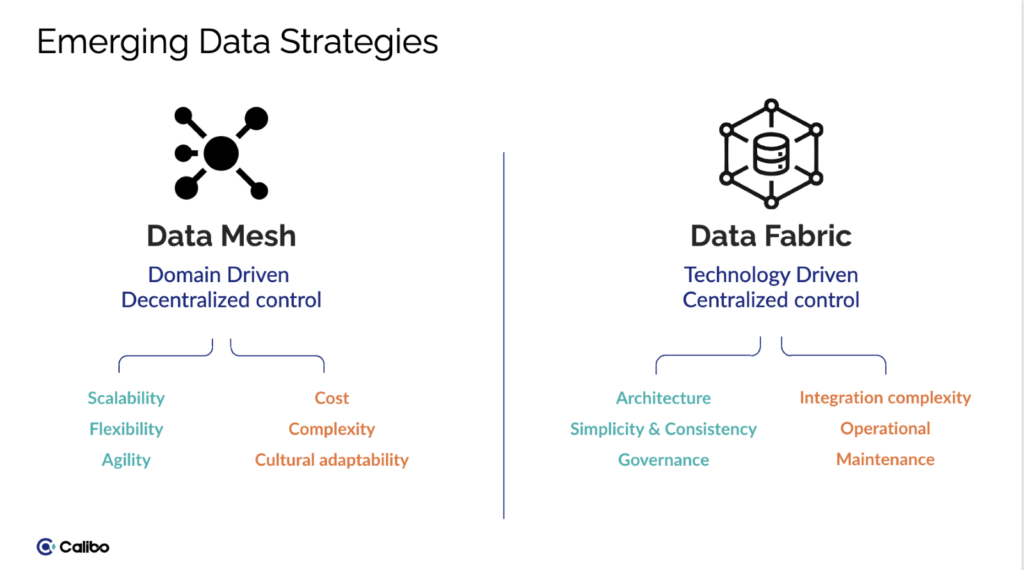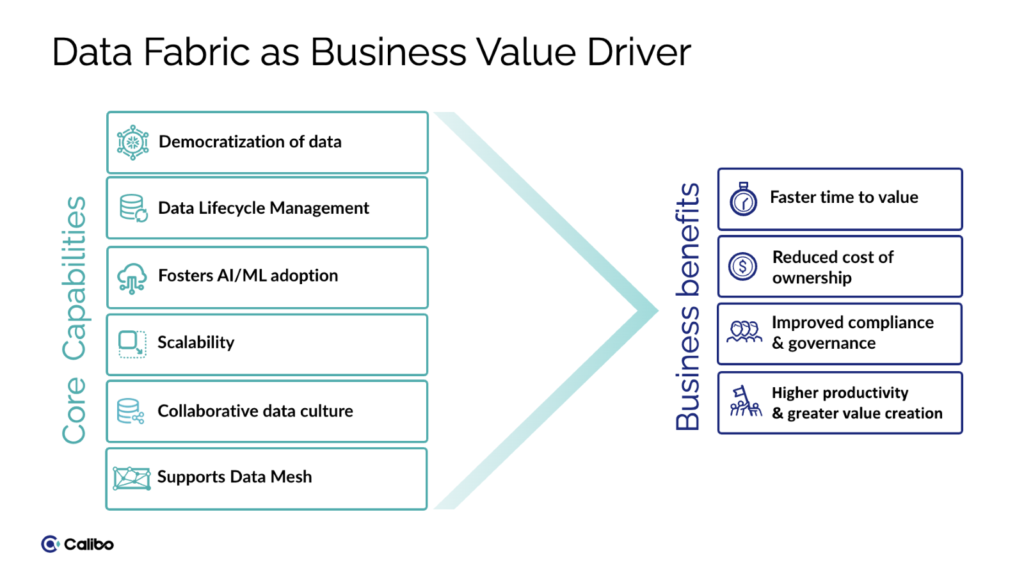

Understanding how to prepare data for AI implementation in 2025 is like having the secret sauce in a Michelin chef’s recipe—essential for success.
After attending the Gartner IT Symposium, Adrian Heim (Head of Sales and Marketing at Calibo) and Cyril Soga (Head of Analyst Relationships at Calibo) discussed the latest trends in AI and data management in a fireside chat-style webinar.
They discussed the latest trends and insights that organizations need to embrace in 2025 and beyond. This blog delves into the strategic technology trends outlined by Gartner and provides a roadmap for making your data AI-ready. Watch the full webinar here.
The power of unconventional solutions
Malcolm Gladwell’s keynote speech during the symposium emphasized the need for radical asymmetric distribution in problem-solving. His talk highlighted how outlier-focused models can lead to more effective solutions, using COVID-19 as a prime example.
Initially, most countries focused on lockdowns based on a conventional bell curve approach, targeting the majority.
However, the key to controlling the virus was understanding that 10% of the population—those emitting significantly more aerosols—played a disproportionate role in spreading the virus. This analogy serves as a powerful reminder that innovative solutions often come from unexpected places, encouraging organizations to adopt unconventional approaches to complex problems.
Top strategic technology trends for 2025
Cyril outlined Gartner’s ten strategic technology trends for 2025, categorized into three primary areas: AI imperatives and risks, new computing frontiers, and human-machine synergy.
AI imperatives and risks
- Agentic AI: Autonomous AI systems capable of solving complex problems independently, raising both opportunities and ethical governance challenges.
- AI governance platforms: Frameworks ensuring AI systems operate ethically, transparently, and in compliance with regulations. These platforms provide the necessary guardrails for autonomous AI systems.
- Disinformation security: Technologies targeting the spread of false information, especially critical in combating deepfakes and maintaining information integrity.
New frontiers of computing
- Post-quantum cryptography: Developing encryption methods that withstand quantum computing capabilities, protecting data against future technological threats.
- Ambient invisible intelligence: Seamless computing that integrates unobtrusively into environments, providing contextual assistance without visible interfaces.
- Energy-efficient computing: Technologies focused on minimizing energy consumption, crucial for the sustainability of large-scale computing tasks like training generative AI models.
- Hybrid computing: Integration of diverse computing paradigms, including quantum and classical computing, to enhance performance and flexibility for specific tasks.
Human-machine synergy
- Spatial computing: Interfaces blending the physical and digital worlds, enabling augmented and virtual reality experiences.
- Polyfunctional robots: Robots capable of performing multiple tasks, revolutionizing workflows in industries like manufacturing.
- Neurological enhancement: Advanced technologies interact with the human brain to augment cognitive functions, transforming how we perceive and interact with the world.
Priorities for AI in enterprises
Looking ahead to 2025, several AI priorities have been identified for enterprises to focus on:
- Decision intelligence: AI-powered decision modeling and simulation, optimizing operations and enabling autonomous decision-making in industries like healthcare and logistics.
- AI agents: autonomous software entities capable of perceiving, deciding, and acting in digital and physical environments, enhancing productivity and responsiveness.
- AI guardrails: essential mechanisms ensuring safety, fairness, and compliance in AI outputs, preventing biased or nonsensical results.
- Actionable and trustworthy AI: blending data-driven and knowledge-driven approaches to deliver reliable outcomes, using tools like ontologies and knowledge graphs.
- Taming AI’s power: Emphasizing sustainable and responsible AI development to address privacy concerns and ethical dilemmas and prevent AI overreach.

The importance of platform engineering
Platform engineering plays a critical role in preparing organizations for AI implementation. It serves as an enabler of efficiency, providing integrated tools and automated processes that simplify the application lifecycle.
Drawing an analogy to a shopping mall, platform engineering offers a ready-to-use environment that eliminates the need to build infrastructure from scratch, allowing developers to focus on innovation.
Data mesh vs. data fabric
The concepts of data mesh and data fabric are advanced approaches to data management.
- Data mesh: Decentralizes data ownership, aligning it with specific business domains. This approach empowers domain teams to manage their data pipelines independently, promoting scalability and agility.
- Data fabric: Provides a unified data management platform, automating data integration, orchestration, and governance across various environments. It supports seamless AI and machine learning adoption through enhanced data management capabilities.


Key takeaways
- Unconventional solutions: Embrace innovative approaches to problem-solving by focusing on outliers and unconventional models.
- Strategic AI trends: Prepare for AI’s evolving role by understanding imperatives like agentic AI, governance platforms, and disinformation security.
- Next-gen computing: explore new computing frontiers with post-quantum cryptography, energy-efficient computing, and hybrid paradigms.
- Human-machine synergy: enhance interactions through spatial computing, polyfunctional robots, and neurological technologies.
- AI in enterprises: focus on decision intelligence, AI agents, and actionable AI to drive strategic initiatives.
- Platform engineering: streamline development with self-service capabilities, accelerating time to market.
- Data management approaches: choose between data mesh and data fabric based on organizational needs or integrate both for maximum impact.
In conclusion, the future of data and AI is rapidly evolving, and businesses must stay ahead by integrating advanced technologies and approaches.
By aligning with the strategic trends and insights discussed at the Gartner IT Symposium, organizations can make their data AI-ready and leverage these innovations to drive growth and competitiveness in 2025 and beyond.
To get the full scoop, watch the full webinar here.
Trending articles

Overcoming the overwhelm: How Enterprise Architects can get more support for technology led innovation
Enterprise Architects (EAs), this one is for you! If the constant pressure to align tech strategies with business goals has you feeling cornered, you’re not alone. Today, you need to juggle numerous challenges—from siloed operations stalling projects to the rapid emergence of AI altering traditional frameworks. Yet, with the right strategies, EAs can transform…

Why combine an Internal Developer Portal and a Data Fabric Studio?
Are you asking this exact question? You’re not alone! Many IT leaders are on a quest to improve efficiency and spark innovation in their software development and data engineering processes. You may wonder why it’s a good idea to combine an Internal Developer Portal and a Data Fabric Studio – what’s the benefit? What IT…

Data mesh vs data fabric: Understanding key differences and benefits
One thing I love about working in tech is that the landscape is constantly changing. Like the weeping angels in Dr Who – every time you turn back and look – the tech landscape has moved slightly. Unlike the weeping angels, however – this progress is for the betterment of all. (And slightly less murderous).…

Best practices for developing AI solutions with a self-service platform
Enterprises are feeling increasing pressure to integrate Artificial Intelligence (AI) into their operations. This urgency is pushing leadership teams to adjust their investment strategies to keep up. Recent advancements in Generative AI (GenAI) are further increasing this pressure, as these technologies promise to enhance productivity and efficiency across the organization. For example, Gartner™ expects GenAI…

More from Calibo
One platform, whether you’re in data or digital.
Find out more about our end-to-end enterprise solution.